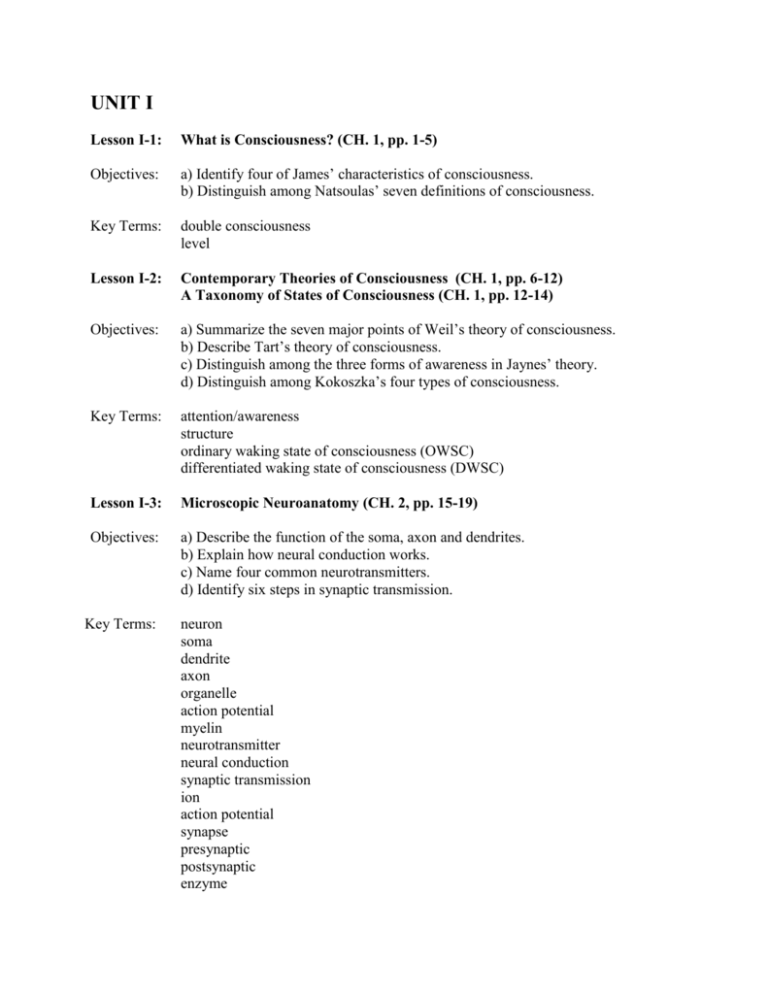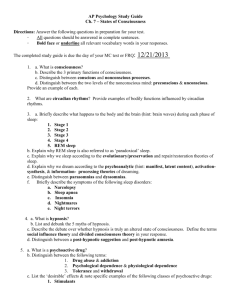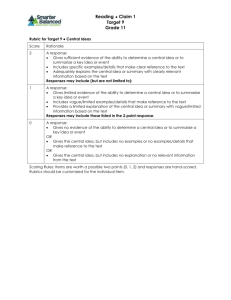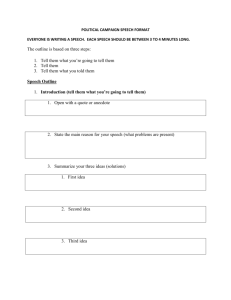UNIT I
advertisement

UNIT I Lesson I-1: What is Consciousness? (CH. 1, pp. 1-5) Objectives: a) Identify four of James’ characteristics of consciousness. b) Distinguish among Natsoulas’ seven definitions of consciousness. Key Terms: double consciousness level Lesson I-2: Contemporary Theories of Consciousness (CH. 1, pp. 6-12) A Taxonomy of States of Consciousness (CH. 1, pp. 12-14) Objectives: a) Summarize the seven major points of Weil’s theory of consciousness. b) Describe Tart’s theory of consciousness. c) Distinguish among the three forms of awareness in Jaynes’ theory. d) Distinguish among Kokoszka’s four types of consciousness. Key Terms: attention/awareness structure ordinary waking state of consciousness (OWSC) differentiated waking state of consciousness (DWSC) Lesson I-3: Microscopic Neuroanatomy (CH. 2, pp. 15-19) Objectives: a) Describe the function of the soma, axon and dendrites. b) Explain how neural conduction works. c) Name four common neurotransmitters. d) Identify six steps in synaptic transmission. Key Terms: neuron soma dendrite axon organelle action potential myelin neurotransmitter neural conduction synaptic transmission ion action potential synapse presynaptic postsynaptic enzyme reuptake Lesson I-4: Objectives: Key Terms: Gross Neuroanatomy (CH. 2, pp. 19-22) a) Describe the function of the CNS and the PNS b) Identify three ways that the two branches of the ANS differ. central nervous system (CNS) peripheral nervous system (PNS) autonomic nervous system (ANS) sympathetic branch parasympathetic branch Lesson I-5: The Central Nervous System (CH. 2, pp. 22-30) Objectives: a) Explain the function of the spinal cord b) Compare the research techniques described in this section. c) Describe the structures that make up the brainstem and cerebrum. Key Terms: computer-assisted axial tomography (CAT scan) magnetic resonance imaging (MRI) positron emission tomography (PET scan) electroencephalogram (EEG) amplitude frequency evoked potential brainstem cerebrum nuclei fiber tracts medulla oblongata ascending reticular activation system (ARAS) cerebellum tectum tegmentum hypothalamus thalamus limbic system basal ganglia cerebral hemispheres commissures corpus callosum cortex sulci fissures gyri frontal lobes occipital lobes parietal lobes temporal lobes primary motor cortex premotor cortex prefrontal cortex Lesson I-6: Toward a Biological Basis of Consciousness (CH. 2, pp. 30-33) Objectives: a) Identify the location of C according to Descartes. b) Summarize the basic ideas of phrenology. c) Explain how the work of Broca and Penfield lent support to the notion of cerebral localization. d) Describe Hughlings Jackson’s notion of a “leading” hemisphere. e) Distinguish between the aphasias discovered by Broca and Wernicke. Key Terms: cerebral localization cerebral specialization cerebral asymmetry phrenology aphasia Broca’s area cerebral dominance apraxia Lesson I-7: Split Brain, Split Consciousness (CH. 2, pp. 33-39) Objectives: a) Compare the theories of Fechner and McDougall. b) Explain why split-brain procedures were first performed. c) Summarize the findings of Akelaitis and of Myers & Sperry. d) Compare the theories of Sperry and Eccles. e) Summarize Gazzaniga’s findings with patient P.S. Key Terms: disconnection syndrome minor hemisphere dominant hemisphere Lesson I-8: Visual Field (CH. 2, pp. 39-41) Altered States of Consciousness & the Split-Brain (CH. 2, pp.41-43) Objectives: a) Identify three ways that information is made available to both hemispheres. b) Summarize the findings of Humphrey & Zangwill. c) Summarize the findings of Greenwood, Wilson, & Gazzaniga. d) Identify two factors that contribute to hypnotic susceptibility. e) Describe the relationship between hypnotic susceptibility and hemispheric activation. Key Terms: visual field collicular commissures hypnotic susceptibility Lesson I-9: Pharmacology of Neurotransmission (CH. 3, pp. 44-47) Basic Pharmacology Concepts (CH. 3, pp. 47-49) Objectives: a) Identify the basic principles that govern all psychoactive drugs. b) Describe three ingredients of drug experiences. c) Name Hebb’s four defining features of neurotransmitters. d) Identify four common neurotransmitters. e) List eight ways that a drug can interfere with neurotransmission. f) Compare the following: drug abuse, drug dependence, and drug addiction. g) Name Julien’s five classes of psychoactive drugs. h) Discuss the limitations of Julien’s classification system. Key Terms: drug psychoactive drug neurotransmitter drug abuse drug dependence drug addiction drug tolerance cross-tolerance Lesson I-10: Sedative-Hypnotic Compounds, Part 1 (CH. 3, pp. 49-52) Objectives: a) Explain how sedative-hypnotic compounds affect the brain. b) Identify medical uses and recreational uses of barbiturates. c) Explain how barbiturates affect the nervous system. d) Describe the short-term effects and withdrawal symptoms of barbiturates. Lesson I-11: Sedative-Hypnotic Compounds, Part 2 (CH. 3, pp. 52-58) Objectives: a) Discuss the various processes used in making alcohol. b) Explain why there is a gender disparity in the ease of intoxication. c) Describe the short-term and chronic effects of alcohol. d) Describe the withdrawal symptoms of alcohol. Key Terms: fermentation malting distillation proof hangover delirium tremens Korsakoff’s syndrome Lesson I-12: Behavioral Stimulants and Convulsants (CH. 3, pp. 58-65) Objectives: a) List five examples of stimulants. b) Indicate the one common property of all these drugs. c) Explain how cocaine affects the CNS and how it induces dependency. d) Compare the three common methods of using cocaine. e) Describe the effects of cocaine on consciousness. f) Explain how crack is produced. g) Discuss chronic effects of cocaine use as well as withdrawal symptoms. Key Terms: cocaine snorting oral method mainlining crack free-basing formication snow lights Lesson I-13: Narcotic Analgesics/Opiates (CH. 3, pp. 65-70) Objectives: a) Give five examples of opiates and their derivatives. b) Identify the two common properties and the medical uses of these drugs. c) Explain how opiates produce their effects. d) List the brain areas where opiate receptors are found in high concentrations. e) Name three natural opiatelike substances found in the brain. f) Explain how opiate use affects enkephalin levels in the brain. g) List the physiological effects of opiates. h) Explain why heroin is more addictive than morphine. i) Describe the characteristics of a heroin “rush.” j) List the withdrawal symptoms of heroin. Key Terms: opiates narcotic sedative analgesic endorphins enkephalins dynorphins heroin morphine rush Lesson I-14: Psychedelics and Hallucinogens, Part 1 (CH. 3, pp. 70-76) Objectives: a) Identify the defining characteristics of psychedelic drugs. b) Describe four classes of psychedelic drugs and give examples of each. c) Discuss the major psychoactive ingredient of marijuana and its source. d) Compare the effects of marijuana and anticholinergic drugs. e) Explain the significance of anandamide. f) Describe the physical and psychological effects of marijuana. g) List the therapeutic uses of marijuana. Key Terms: hallucination hallucinogens psychedelic drugs acetylcholine psychedelics norepninephrine psychedelics psychedelic anesthetics cannabis drugs Cannabis sativa cannabinoids delta-9-tertrahydrocannabinol (THC) anandamide expectancy effect amotivation syndrome Lesson I-15: Psychedelics and Hallucinogens, Part 2 (CH. 3, pp. 76-81) Objectives: a) Discuss the chemical structure of LSD. b) Explain how and where LSD produces its effects in the brain. c) Describe the psychological and physiological effects of LSD. d) Discuss the features of a “bad trip.” e) Explain why LSD users may experience flashbacks. Key Terms: psychomimetic effects synthesia flashbacks Lesson I-16: Focus Topic 1 “The Concept of Consciousness” by G. William Farthing Objectives: a) Distinguish between consciousness and mind. b) Describe the three meanings of consciousness described in this reading. c) Explain how cognitive psychologists see the relationship of consciousness to working memory and attention. d) Distinguish between primary and reflective consciousness. e) Distinguish between focal and peripheral awareness. f) Identify four types of nonconscious mental contents and processes. g) Explain how Kihlstrom uses the terms “subconscious” and “unconscious.” Key terms: working memory controlled process automatic process attentional capacity introspection fugue dissociation hypothesis “The Stream of Consciousness” by William James Objectives: h) Describe James’ four characteristics of consciousness. “Mind and Body: Rene Descartes to William James” by Robert H. Wozniak (Sections 1-4) Objectives: i) Summarize the philosophy of dualism presented by Descartes in Meditationes. j) Describe the dual-aspect theory of Spinoza. k) Explain Leibniz’ notion of psychophysical parallelism. l) Describe Berkeley’s immaterialism. m) Explain why LaMettrie’s work, L’homme machine, was groundbreaking. n) Summarize the philosophy of Cabanis. o) Describe James’ “solution” to the mind-body problem. Key terms: materialism epiphenomenalism neutral monism mind-stuff theory UNIT II Lesson II-1: Hypnosis and Consciousness (CH. 4, pp. 82-83) Historical Development (CH. 4, pp. 83-86) Objectives: a) Describe three ways of describing the processes underlying hypnosis. b) List common experiences of hypnotized individuals. c) Identify the contributions of Mesmer, Elliotson, Esdaile, Braid and Faria to the development of hypnosis. Key Terms: hypnosis animal magnetism mesmerism selective attention Lesson II-2: Assessing Hypnotic Susceptibility (CH. 4, pp. 86-90) Objectives: a) Describe the features of the SHSS, BSS and HGSHS. Key Terms: Stanford Hypnotic Susceptibility Scale (SHSS) Barber Suggestibility Scale (BSS) Harvard Group Scale (HGSHS) Hypnotic Induction Profile (HIP) Lesson II-3: Correlates of Hypnotizability (CH. 4, pp. 90-93) Objectives: a) Summarize the findings of Wallace et al. b) Identify the cognitive, personality and physiological correlates of hypnotic susceptibility. Lesson II-4: Hypnotherapy (CH. 4, pp. 93-97) Objectives: a) Summarize the findings of Stanton’s study of hypnosis and obesity. b) Compare the use of hypnosis in treating obesity and smoking. c) Discuss the effectiveness of hypnosis in the treatment of smoking. d) Explain what happens when hypnosis and systematic desensitization are combined in the treatment of phobias. e) Describe Erickson’s technique for treating premature ejaculation. f) Identify at least three psychological disorders for which hypnosis has been shown to be an effective treatment. Key Terms: systematic desensitization Lesson II-5: Hypnosis and Pain Control (CH. 4, pp. 97-100) Objectives: a) Distinguish between analgesia and anesthesia. b) Identify two benefits of using hypnosis for surgical anesthesia. c) Explain why hypnosis reduces the experience of pain. d) List three advantages of using hypnotic anesthesia during childbirth. e) Distinguish among the two hypnotic procedures used to treat headaches. Key Terms: analgesia anesthesia glove anesthesia hand warming Lesson II-6: Hypnosis and Memory (CH. 4, pp. 100-102) Hypnosis and Perception (CH. 4, pp. 102-103) Objectives: a) Distinguish between amnesia and hyperamnesia. b) Describe the effects of hypnosis on semantic and episodic memory. c) Explain why the use of hypnosis in court cases is problematic. d) Summarize the findings of Walker et al. e) Describe the effects of hypnosis on visual acuity, hearing, and performance on the Stroop task. Key Terms: amnesia hyperamnesia hypnotic age regression eidetic memory Lesson II-7: Contemporary Theories of Hypnosis (CH. 4, pp. 103-107) Objectives: Key Terms: a) Distinguish among the three major theories of hypnosis. b) Summarize Hilgard’s findings on cold-pressor pain and on the hidden observer. c) List the variables that appear to be important to the success of role enactment. d) Summarize the findings of Spanos et al. in support of task-motivation theory. e) Summarize the findings of Johnson et al.on trance logic. trance theory cold-pressor pain hidden observer automatic writing sociological theory task-motivation theory trance logic Lesson II-8: Biofeedback and Consciousness (CH. 5, pp. 108-110) Historical Development (CH. 5, pp. 110-115) Objectives: a) List five physiological responses that biofeedback can bring under conscious control. b) Explain how the process of biofeedback works. c) Identify Miller & Konorski’s incorrect assumption about involuntary responses. d) Explain how curare was used to challenge the mediation hypothesis. e) Summarize the contribution of Kamiya to biofeedback research. Key Terms: biofeedback galvanic skin response (GSR) skeletal mediation curare Lesson II-9: The Biofeedback Training Process (CH. 5, pp. 115-120) Objectives: a) List the conditions under which the use of biofeedback is contraindicated. b) Describe the characteristics of a trainer that can have a positive influence on biofeedback training. c) List the similarities and differences among the three types of biofeedback instruments. d) Describe the four types of training sessions. Key Terms: trainee trainer Lesson II-10: Biofeedback Applications (CH. 5, pp. 120-130) Objectives: a) Identify the three types of biofeedback applications. b) Describe the six defining features of tension headaches and the underlying physiological mechanism of tension headaches. c) Describe the type of biofeedback used in treating tension headaches. d) Summarize the findings of Buzynski. e) Identify two personality variables that influence the effectiveness of biofeedback as a treatment for tension headaches. f) Compare the effectiveness of relaxation and EMG biofeedback in treating tension headaches. g) Distinguish among the four types of migraine headaches. h) List the four most common characteristics of migraine headaches. i) Discuss the effectiveness of biofeedback in treating migraine headaches. j) Describe the characteristics of an asthmatic episode and identify three factors that contribute to asthma. k) Summarize the findings of Weiner. l) Compare the two biofeedback procedures used in treating asthma. Key Terms: headache tension headache EMG feedback-assisted relaxation classic migraine common migraine cluster headaches hemiplegic/opthamoplegic migraine asthma Lesson II-11: Biofeedback and the Production of Altered States (CH. 5, pp. 130-132) Objectives: a) Describe the hypothesized relationship between alpha and mental state. b) Cite evidence for and against the existence of an “alpha experience.” c) Summarize the findings of Dewan. Lesson II-12: Meditation and Consciousness (CH. 6, pp. 134-136)/ Historical Development (CH. 6, pp. 136-138) Objectives: a) Compare hypnosis and meditation. b) Identify two reasons why initial attempts at self-hypnosis or meditation fail. c) Summarize the role of meditation in Buddhism, Hinduism, Christianity and Judaism. d) Describe the basic teachings of the Visuddhimagga. e) Discuss the contributions of the Maharishi Mahesh Yogi. Key Terms: autohypnosis nirvana jhana mantra Lesson II-13: Meditative Styles (CH. 6, pp. 138-143) Objectives: a) Distinguish among the four popular forms of concentrative meditation. b) Describe the role of the mandala, mantra and mudra in yoga meditation. c) Compare opening-up (mindfulness) meditation to concentrative meditation. Key Terms: Zen lotus position koan yoga mandala tratakam mudra transcendental meditation (TM) Sufism zikr Lesson II-14: Contemporary Theories of Meditation (CH. 6, pp. 144-148) Objectives: a) Describe Deikman and Ornstein’s bimodal concept of consciousness. b) Identify Welwood’s four levels of awareness. c) Explain Washburn’s three-level theory of meditation. d) Summarize the basic ideas in Walsh’s S-R model of meditation. e) Describe the effects of meditation on habituation. Key Terms: active mode receptive mode deautomatization habituation orienting response dishabituation Lesson II-15: Correlates of Meditation (CH. 6, pp. 148-153) Objectives: a) List the psychological benefits of meditation. b) Summarize the findings of Kasamatsu & Hirai. c) Summarize the findings of Wallace and Benson. d) Identify two criticisms of Holmes’ position. e) Summarize the criticisms of Holmes’ report. f) Describe the effects of meditation on mood and on sleep habits. g) List the reported effects of collective meditation. Lesson II-16: Focus Topic 2 “The Psychological Unconscious” by John F. Kihlstrom Objectives: a) List three characteristics of Shevrin & Dickman’s dynamic unconscious. b) Distinguish among the Cs, PCs, and UCs, according to Freud. c) Explain how Hilgard’s neodissociation theory works. d) Identify the two defining features of an automatic process. e) Explain how the findings of Nelson (1978) show that implicit memory exists. f) Distinguish between implicit and explicit memory. g) Give three examples of implicit memory in patients with dissociative disorders. h) Summarize the findings of Kihlstrom et al (1990) with anesthetized patients. i) Explain how the findings of Silverman show that implicit perception exists. j) Describe Weiskrantz’s study of “blindsight.” k) Explain how the findings of Shames (1994) show that implicit thought exists. l) Summarize the findings of Reber’s artificial grammar studies. m) List Lang’s three components of emotion. n) Explain how the findings of Weinberger et al (1979) show that implicit emotion exists. o) Explain how the findings of Bowers (1975) show that implicit motivation exists. p) Distinguish among Kihlstrom’s concepts of unconscious, preconscious and subconscious. Key terms: priming effect implicit memory desynchrony posthypnotic suggestion UNIT III Lesson III-1: Sleep, Dreams, and Consciousness (CH.7, pp. 154-155) Historical Development (CH. 7, pp. 155-158) Objectives: a) Summarize the findings of Loomis, Harvey, and Hobart. b) Describe the first two major research techniques used to study the sleep/wake cycle. c) Summarize Nauta’s study on rats. d) Summarize the findings of Anerinsky and Kleitman. Key Terms: sleep dreams waking center sleep center Lesson III-2: Sleep, Dreams, and the EEG (CH. 7, pp. 158-166) Objectives: a) Indicate the amount of your life spent sleeping and dreaming. b) Describe the effects of the reticular formation on wakefulness. c) Summarize the findings of Aserinsky & Kleitman. d) Differentiate among the four types of brain waves. e) Describe each of the five stage of sleep. f) Explain how hemispheric activity is affected by different sleep stages. g) Describe the characteristics of a typical night’s sleep. h) Identify the effects of night shifts, age and strokes on sleep patterns. Key Terms: electroencephalograph electroencephalogram (EEG) amplitude frequency sleep spindle k-complex paradoxical sleep REM sleep electrooculogram (EOG) Lesson III-3: Sleep Deprivation (CH. 7, pp. 166-169) Sleep Learning (CH. 7, pp. 169-170) Objectives: a) Describe the symptoms of sleep deprivation. b) Compare the effects of sleep deprivation on Tripp and on Gardner. c) Explain how sleep deprivation affects memory. d) Describe the effects of REM deprivation. e) Summarize the conclusions of Webb & Cartwright. Key Terms: sleep deprivation REM-rebound effect hypnopedia Lesson III-4: Sleep Disorders (CH. 7, pp. 170-174) Theories of Sleep (CH. 7, pp. 174-175) Objectives: a) Identify the percentage of American adults who complain of insomnia. b) Describe two types of insomnia. c) Compare the effectiveness of progressive relaxation and stimulus control in the treatment of insomnia. d) Discuss the symptoms and methods of treatment for sleep apnea. e) Identify three periodic disorders associated with narcolepsy. f) Compare the active and passive theories of sleep. Key Terms: sleep onset insomnia subjective insomnia sleep apnea narcolepsy nocturnal panic somnambulism REM-sleep behavior disorder nocturnal enuresis night terrors reparative theory reticular hypothesis Lesson III-5: On Dreams and Dreaming (CH. 7, pp. 175-178) Theories of Dream Activity (CH. 7, pp. 178-181) Objectives: a) Identify activities and themes commonly occurring in dreams. b) List possible factors that can influence dream recall. c) Summarize the findings of Foulkes and of LaBerge et al. d) Identify two functions of dreams, according to Freud. e) Identify two functions of dreams, according to Jung. f) Describe the theories of: Cartwright, Hobson & McCarley, and Crick & Mitchison. Key Terms: lucid dreams dream work manifest content latent content problem-solving theory activation-synthesis hypothesis Lesson III-6: Daydreaming (CH. 7, pp. 181-183) Sexual Fantasies (CH. 7, pp. 183-184) Objectives: a) Distinguish between Singer’s two categories of daydreams. b) List four types of stream-of-consciousness daydreams. c) Compare the daydreams of women and men. d) Describe two models that explain the function of daydreams. Key Terms: daydreaming Lesson III-7: Sensory Deprivation and Consciousness (CH. 8, pp. 185-187) Historical Background (CH. 8, pp. 187-189) Objectives: a) Distinguish between REST and meditation. b) Describe three major influences on the study of sensory deprivation. Key Terms: sensory deprivation Restricted Environment Stimulation Technique (REST) perceptual isolation Lesson III-8: The McGill Studies (CH. 8, pp. 189-190) Sensory Deprivation After McGill (CH. 8, pp. 190-193) Objectives: a) Summarize the procedures and findings of the McGill studies. b) Offer evidence for and against the idea that sensory deprivation produces hallucinations. c) Give three reasons why interest in sensory deprivation waned after the McGill studies. d) Identify two events that led to renewed interest in sensory deprivation starting in the mid-1970’s. Lesson III-9: Experimental Procedures (CH. 8, pp. 193-195) Restricted Environmental Stimulus Theory (CH. 8, pp. 195-197) Objectives: a) Describe three procedures used to reduce sensory input. b) Compare the theories of Rosenzweig, Robertson, Lindsley and Ziskind. Key Terms: perceptual monotony variation reduction external stimuli internal stimuli ascending reticular activating system (ARAS) Lesson III-10:Sensory Deprivation & Altered States of Consciousness (CH. 8, pp. 197-199) Clinical Potential of Sensory Deprivation (CH. 8, pp. 199-201) Objectives: a) Explain how sensory deprivation has influenced the world’s major religions. b) Describe Lilly’s view of the mind. c) Identify the two major uses of the immersion tank according to Lilly. d) Summarize the findings of Suedfeld & Ikard. e) Summarize the findings of Barabasz & Barabasz. f) Summarize the findings of Ramirez, Suedfeld, & Remick. Key Terms: sensed presence Lesson III-11:Paraspychology and Consciousness (CH. 9, pp. 202-203) Historical Development (CH. 9, pp. 203-205) Objectives: a) Identify the influence of James and McDougall on parapsychology. b) Describe the research of Rhine & Rhine using Zener cards. Key Terms: psychical research (psi) extrasensory perception (ESP) psychokinetic (PK) abilities parapsychology mediumship Lesson III-12:Extrasensory Perception (CH. 9, pp. 205-209) Objectives: a) Describe a case study suggesting the existence of clairvoyance. b) Summarize the findings of Friedman, Schmeidler, and Dean. c) Explain how telepathy differs from clairvoyance and precognition. Key Terms: clairvoyance precognition telepathy remote viewing Lesson III-13:Factors Influencing Experimental Findings (CH. 9, pp.209-211) Psychokinesis (CH. 9, pp. 212-216) Objectives: a) Describe the typical ganzfeld experiment. b) Identify personality correlates of belief in paranormal phenomena. c) Name two factors that appear to improve ESP abilities. d) Give at least five examples of research showing the relationship between hypnotic susceptibility and ESP performance or belief. e) Describe a case study suggesting the existence of PK. f) Give an example of a possible poltergeist phenomena. g) Identify potential uses of Kirlian photography. h) Summarize the findings of Schmidt, Morris, and Rudloph. Key Terms: ganzfeld sheep goats psychokinesis (PK) poltergeist Kirlian photography Lesson III-14:The Out-of-Body Experience (CH. 9, pp. 216-218) The Near-Death Experience (CH. 9, pp. 218-220) Objectives: a) List experiences that commonly accompany OBEs. b) Evaluate Salley’s explanations of OBEs. c) Identify common features of NDEs. d) Summarize the findings of Ring. e) Evaluate existing explanations of NDEs. Key Terms: out-of-body experience (OBE) near-death experience (NDE) Lesson III-15:Psychic Healing (CH. 9, pp. 220-222) General Theories of Parapsychology (CH. 9, pp. 222-225) Objectives: a) Compare the theories of Walker, Stanford, and Schmidt. b) List seven common criticisms of parapsychology. c) Explain how parapsychologists would respond to these criticisms. Key Terms: psychic healing Lesson III-16:Focus Topic 3 “Lucidity Research, Past and Future” by Stephen LaBerge Objectives: a) Compare the effects of dreamed and actual experiences on the brain. b) Explain how lucid dreamers communicate with researchers. c) Summarize the findings on subjective “dream time.” d) Describe what happens to brain lateralization during lucid dreaming. e) Compare the body’s responses to normal and lucid dreaming. Key terms: lucid dreaming “Does Psi Exist?” by Daryl J. Bem & Charles Honorton Objectives: f) Compare the attitudes of psychologists and other academicians about psi. g) Give three reasons why psychologists are skeptical about psi. h) Describe the relationship of meditation and hypnosis to psi. i) Summarize the findings of research on dream-mediated psi. j) Describe the ganzfeld procedure. k) Compare the psi ganzfeld effect with the results of a 1988 aspirin study. l) Summarize the findings of the autoganzfeld study with the Julliard sample. m) Discuss the possible relationship of psi and Bell’s theorem. Key terms: psi “The Source of Creative Power” by Victor Shamas Objectives: n) Distinguish between the finite mind and infinite mind, according to Shamas. o) Compare the finite and infinite minds with respect to James’ characteristics of consciousness.




